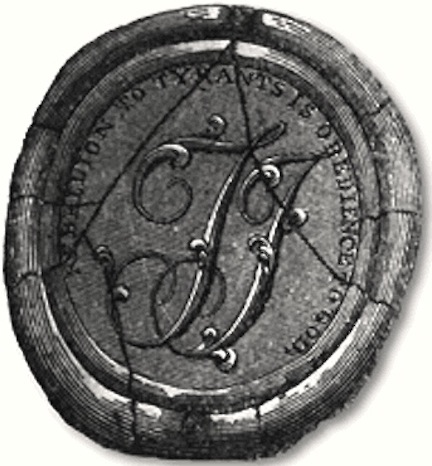 The Flat Hat Club Membership Medal
The Flat Hat Club Membership Medal
(F.H.C Society)
On November 11, 1750 a secret fraternity called the F.H.C Society established itself at the College of William & Mary in Williamsburg, VA. Notable members included St. George Tucker, Thomas Jefferson, and George Wythe. Apparently, it derived it’s name, “Flat Hat Club” from a public nickname given to the members of the F.H.C Society. This was actually the first collegiate secret society established in the colonies of America. This club was the predessessor to Phi Beta Kappa established at the college later in 1776. The fraternity most likely got together to talk about societies social and political issues and events. They ended up being responsible for the creation of a weekly student newspaper in 1911, and still currently prints today. It was originally printed as a Broadsheet, but today it’s front and back page are printed in color and the pages inside are printed in black and white. Today it features regular columns such as, “Behind Closed Doors” and the “Confusion Corner.”
Grand Master Mason Fraternity Button
Hand Cut by
Robert Scot

GWI 22-A
Robert Scot’s Scrolling Monogram Art
Letter Cutting W/ Snakes
In GWI 22, we see a perfect example of Robert Scot’s signature Scrolling Monogram Art letter cutting. This represent a freehand in engraving. I believe he used the design off GWI 22 and cut this as a Grand Master Mason Fraternity Pin. Some quick notes on reflections of Scottish Masonry Symbols. We have the only known depiction of the Honey Bee Hive in the Phrygian Cap. The dotted pattern in the foilage is actually the Honey Bees working around the Hive in his interest. The leaves represent both the Snake and the Worm. The worm being the religious authority using a Christianity’s Jesus referance. This is nearly identical to the style of letters that were cut in the only surviving medallion of the Fat Hat Club, the 1780 Second Seal of William & Mary College, the Lawrence Washington Seal, and Thomas Jefferson’s own (lost) personal seal. This clearly shows how Robert Scot used the ancient “Snakes” metaphor depiction on his monogramed letters.

Lawrence Washington Seal
22 x 25 cm.
Lawrence Washington is the fourth son of George Washington’s youngest Brother Samuel Washington. When Samuel died in 1781, George Washington took it upon himself to provide for his nephew’s education and well being. This serves as a wonderful association between Robert Scot and George Washington’s family. The seal is a blue, and has the calligraphic letters, “LW” with the same 7 petal flower adornment found on the Great Seal of the United States. The seal is set within a gold holder. Here we see Robert Scot’s use of Snakes heads clearly in his transformational Scrolling Art. If we look at the monograms letter ends, we can clearly see snake heads in the disguise of foliated leaf tips. This depiction of snakes is thought to represent symbolism associated with the Tribe of Dan. Possibly the Pictish Snake history.

Thomas Jefferson’s Lost Seal
Pictured above is Thomas Jefferson’s lost seal. There is some supporting evidence that this seal was first ordered (commissioned) to Robert Scot on March 26, 1786. Here we see the same Pictish Snakes that is found in the ancient Pictish stones that depicted mythological creatures. Robert Scot would have been familiar with the Pictish Beast of Dragon that is a well known to all Scottish people. He must have took a liking to this snake representation because he produced it in several works including GW inaugural buttons (GWI 22-A). We also find Robert Scot’s prominent maker’s marks “ST” in the motto where it says, “IS.”
Pictish Beast Dragon
Snakes
The earliest known intact copy of Jefferson’s seal appears on a letter to Richard Gem on April 4, 1790. The seal then appears infrequently on several Jefferson related artifacts including on the frontispiece of Henry Randall’s, “Life of Thomas Jefferson,” and is adorned on one of the gates to the Monticello Graveyard. The motto, “Rebellion to Tyrants is Obedience to God,” was a motto suggested for the Great Seal of the United States, but ultimately rejected for E. Pluribus Unum. Jefferson must have taken a fancy to it because he appropriated it for his personal seal. I was unable to find the original source of the quotation, but was able to find some earlier English and Colonial reference points. The earliest use of the motto was on an epitaph dated 1602-1659 of John Bradshaw. He was a British judge who presided over the trial of King Charles I. Then in 1687, the motto was used by Robert Treat Paine, the governor over the colony of Connecticut when he refused to give up the colony charter. We also know that it was a favorite of America’s Benjamin Franklin.
